By The Siberian Times reporter
03 June 2016
Ancient mummy preserved by permafrost dressed up for her debut 21st century appearance despite calls for solemn reburial from native peoples.
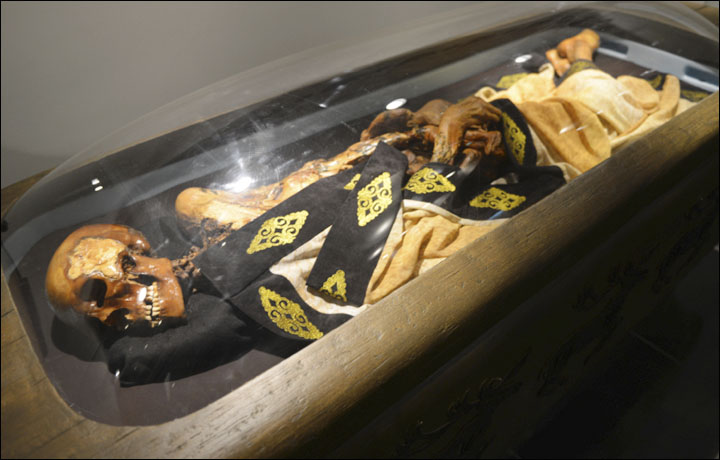
The 'ice princess' will be dressed in a stylised cover made to resemble her real life marmot fur coat, discreetly draped over the mummy, who experts says was an elite member of her ancient culture. Picture: Alexander Tyryshkin
The well-preserved 25 year old woman - who probably died from breast cancer - was dug from her ice-clad tomb in 1993 by Russian archeologists, but this is the first time her remains will be publicly displayed.
Analysis of her body and the artifacts in her elite tomb brought modern scientists unprecedented knowledge of the ancient Pazyryk culture which once held sway in southern Siberia.
Among the remarkable discoveries were 'modern-looking' artistic tattoos on her skin.
Her body art - seen in our pictures - has won acclaim around the world, and will be visible on her shoulders and fingers despite a decision to cover her modesty in a 'fur coat-style blanket'.
The move to display the mummy in the Anokhin National Museum in Gorno-Altaisk is seen as controversial, even though the remains in a specially built sarcophagus will be viewed only twice a week for a maximum of three hours on each day to ensure she is not damaged. Earlier museum officials appeared to give assurances she would not be displayed.
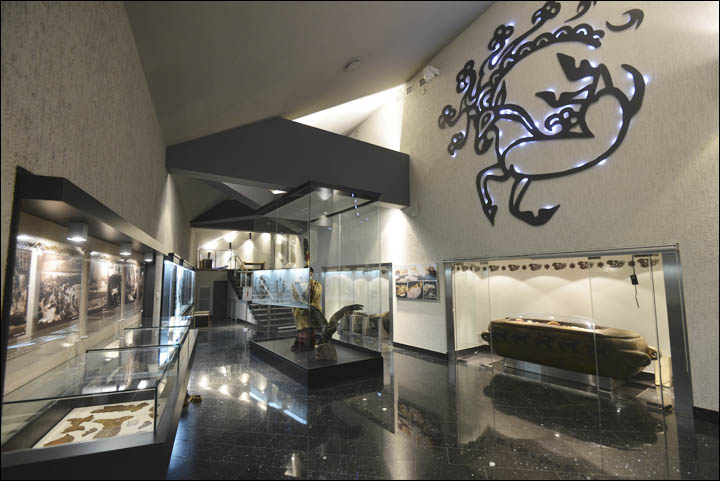
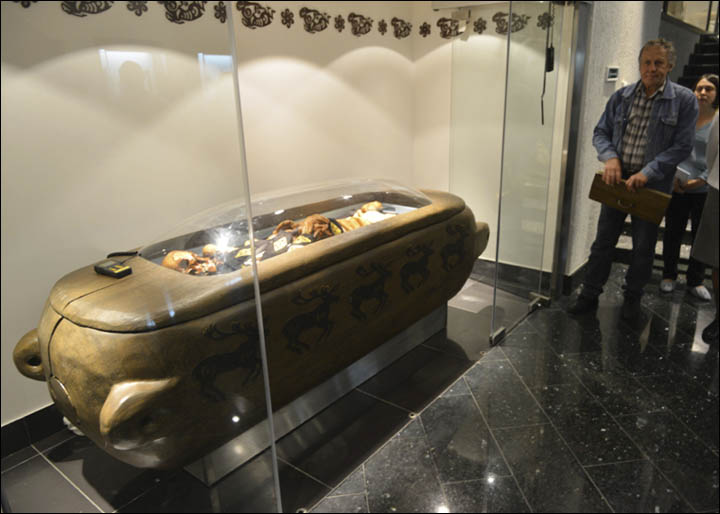
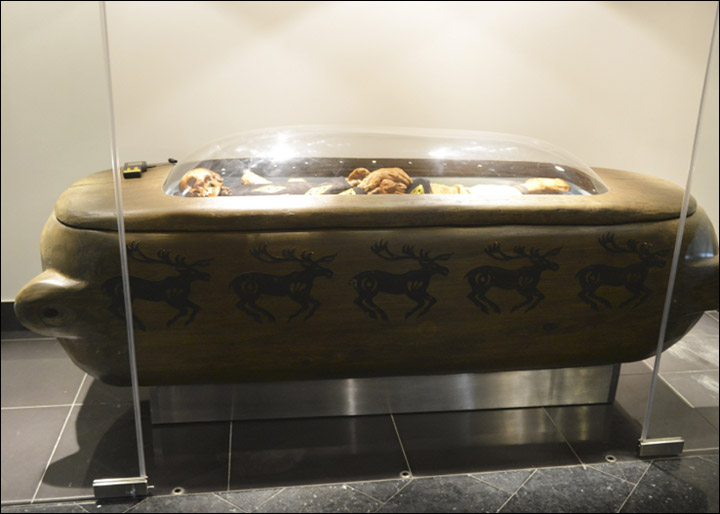
Leading researcher of the All-Russian Research Institute of Medicinal and Aromatic Plants (Moscow), Dr Yuri Abramov, said: told: 'We made sure of the absolute safety of the mummy.' Pictures: Alexander Tyryshkin
The 'ice princess' will be dressed in a stylised cover made to resemble her real life marmot fur coat, discreetly draped over the mummy, who experts says was an elite member of her ancient culture.
The Moscow institute which preserves the remains of Bolshevik revolutionary Vladimir Lenin - who died in 1924 - is ensuring the remains stay in a good condition.
Rimma Erkinova, museum director, said lunar considerations would determine when the mummy - known as Princess Ukok after the plateau where archeologists opened her burial chamber - goes on display for the first time. 'The Altai people try to do all great things at the time of the new moon,' she explained.
Despite this, native ethnic groups in the Altai Republic have demanded that the tattooed remains should be reburied at the site where they were dug up, warning that a failure to do so will inflict terrible natural disasters on the world.
Detailed scientific analysis has shown that the 'princess' - who lived five centuries before Christ - almost certainly died from breast cancer, and that her illness may have caused a fall, probably from a horse, which compounded her health problems. She is believed to have taken cannabis to ease her suffering.
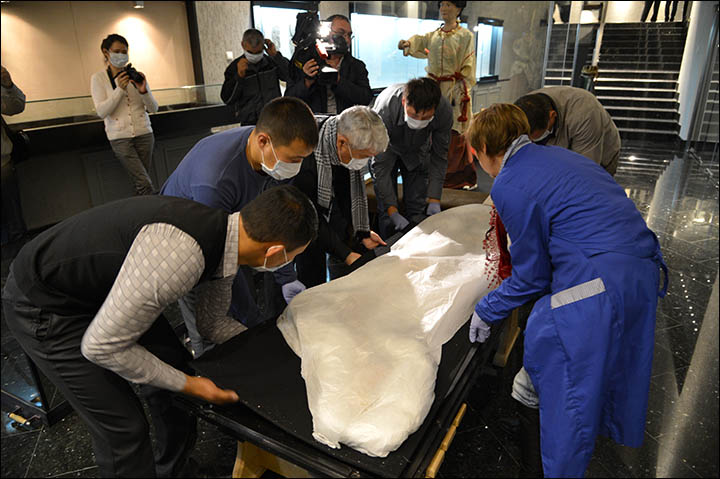
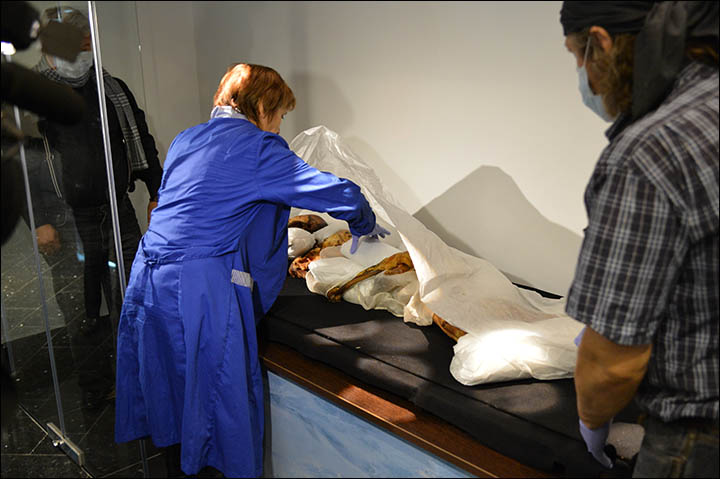
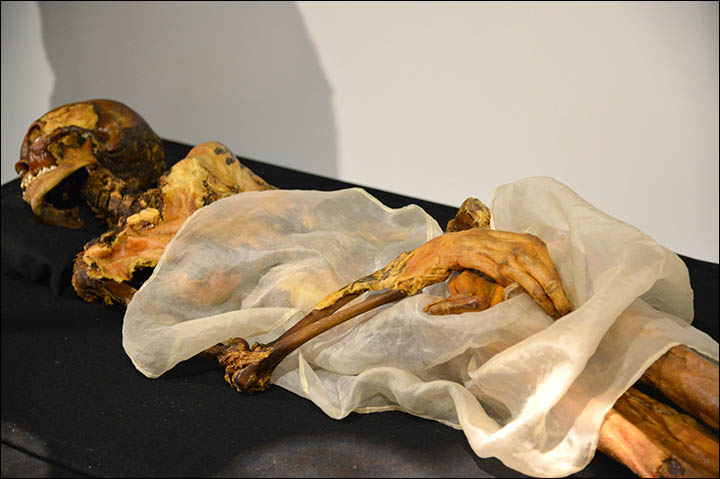
The mummy is getting inside a sarcophagus of Anokhin museum, Gorno-Altaisk, under a watchful eye of Irina Salnikova, head of the Siberian Branch of Russian Academy of Sciences Museum of Archeology and Ethnography. Pictures: Alexander Tyryshkin
Buried around her were six horses, saddled and bridled as her spiritual escorts to the next world, along with a meal of sheep and horse meat.
Archaeologists also found ornaments made from felt, wood, bronze and gold as well as a small container of cannabis and a stone plate on which coriander seeds were burned.
From her clothes and possessions including a 'cosmetics bag', scientists were able to recreate her fashion and beauty secrets. Her head was completely shaved, and she wore a horse hair wig on top of which was a carving of a wooden deer. The ancient woman's face and neck skin was not preserved, but the skin of her left arm survived.
The most exciting discovery was her elaborate body art, which many observers said bore striking similarities to modern-day tattoos.
On her left shoulder was a fantastical mythological animal made up of a deer with a griffon's beak and a Capricorn's antlers. The antlers themselves were decorated with the heads of griffons. The mouth of a spotted panther with a long tail could also be seen, and she had a deer's head on her wrist.
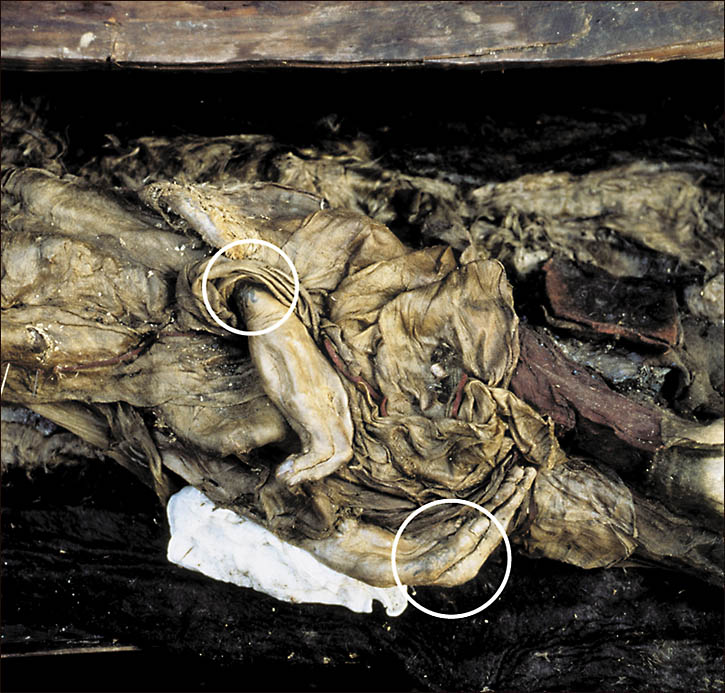
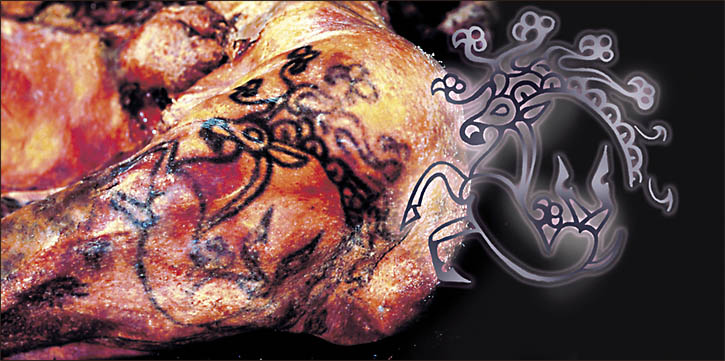
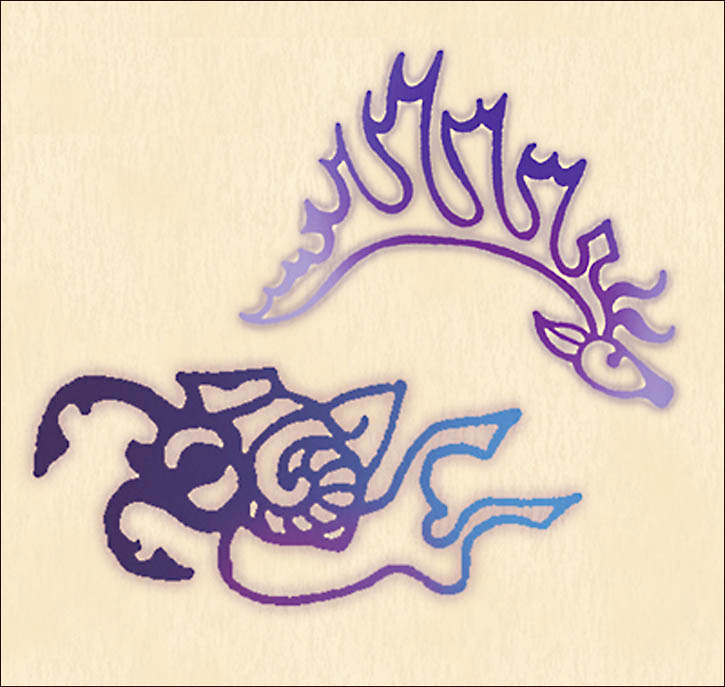

Her body art - seen in our pictures - has won acclaim around the world, and will be visible on her shoulders and fingers despite a decision to cover her modesty. The drawings made by Elena Shumakova, Institute of Archeology and Ethnography, Siberian Branch of Russian Academy of Science
Leading researcher of the All-Russian Research Institute of Medicinal and Aromatic Plants (Moscow), Dr Yuri Abramov, said: told: 'We made sure of the absolute safety of the mummy.'
Earlier, Akai Kine, leader of the Teles ethnic group and president of the Spiritual Centre of the Turks, Kin Altai, went to court in a failed attempt to demand reburial of the mummy. Her removal from her burial chamber flouted ancient and local beliefs, he said.
'The dead cannot be disturbed, and especially they cannot be held on public display and carried around the world. After she was dug out, we immediately saw earthquakes, floods, and hail which were not known previously.'
He described her as the White Lady, a priestess guarding 'the umbilical cord of the Earth'. 'She stood as a guard at the gates of the underworld, preventing the penetration of evil from the lower worlds.
'However, after archaeologists removed the mummy, it has lost its strength and can no longer perform its protective function. So evil started to penetrate, natural disasters and human conflicts began.'

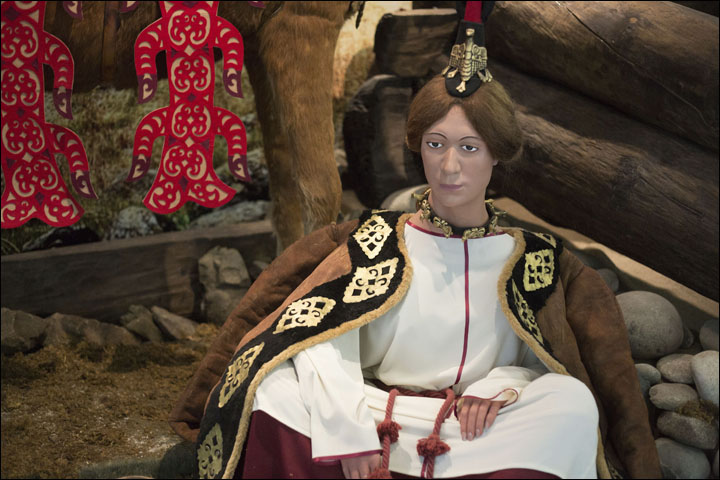
Reconstruction of Pazyryk woman's costume. Right, Pazyryk man's costume. Reconstruction by D. Pozdnyakov, Institute of Archeology and Ethnography, Siberian Branch of Russian Academy of Science.
Collection keeper Sergey Kireev said Moscow scientists had given approval to display the mummy and also the use of the 'fur' cover. Earlier this year he was quoted saying: 'The mummy will be safely kept in our museum, without going to public display.'
The mummy's lavish grave suggests she was someone of singular importance.
An MRI, conducted in Novosibirsk by eminent academics Andrey Letyagin and Andrey Savelov, showed that the 'princess' suffered from osteomyelitis, an infection of the bone or bone marrow, from childhood or adolescence.
Close to the end of her life, she was afflicted, too, by injuries consistent with a fall from a horse: but the experts also discovered evidence of breast cancer.
'When she was a little over 20 years old, she became ill with another serious disease - breast cancer. It painfully destroyed her' over perhaps five years, said a summary of the medical findings in 'Science First Hand' journal by archeologist Professor Natalia Polosmak, who first found these remarkable human remains in 1993.
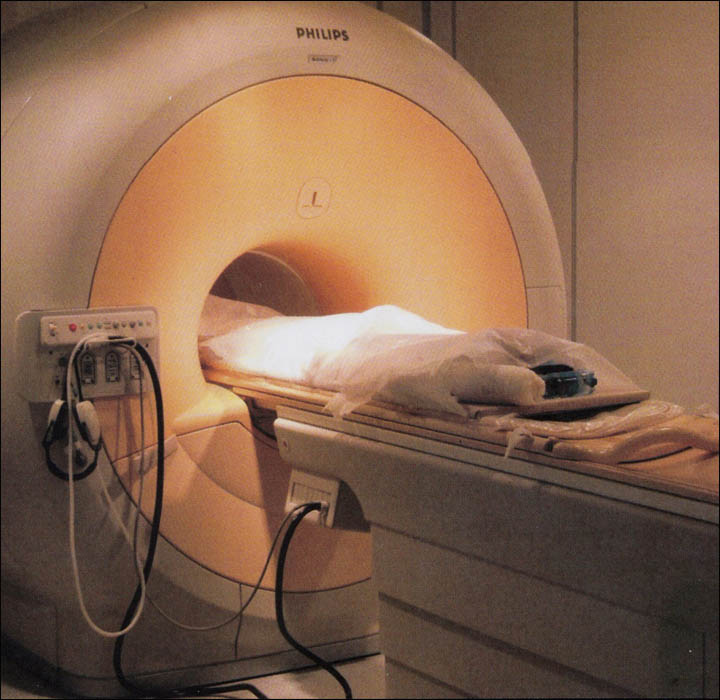
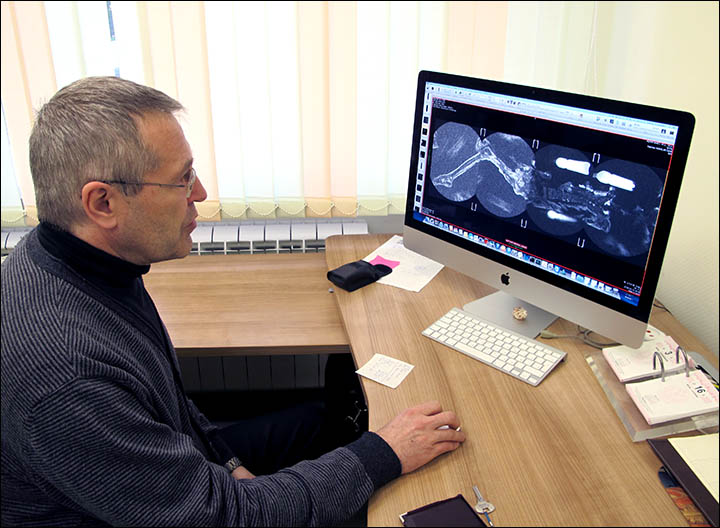
Eminent academics Andrey Letyagin: 'I am quite sure of the diagnosis - she had cancer.' Pictures: 'Science First Hand', The Siberian Times
'During the imaging of mammary glands, we paid attention to their asymmetric structure and the varying asymmetry of the MR signal,' stated Dr Letyagin in his analysis. 'We are dealing with a primary tumour in the right breast and right axial lymph nodes with metastases.'
'The three first thoracic vertebrae showed a statistically significant decrease in MR signal and distortion of the contours, which may indicate the metastatic cancer process.'
He concluded: 'I am quite sure of the diagnosis - she had cancer.
'She was extremely emaciated. Given her rather high rank in society and the information scientists obtained studying mummies of elite Pazyryks, I do not have any other explanation of her state. Only cancer could have such an impact.'
No comments:
Post a Comment